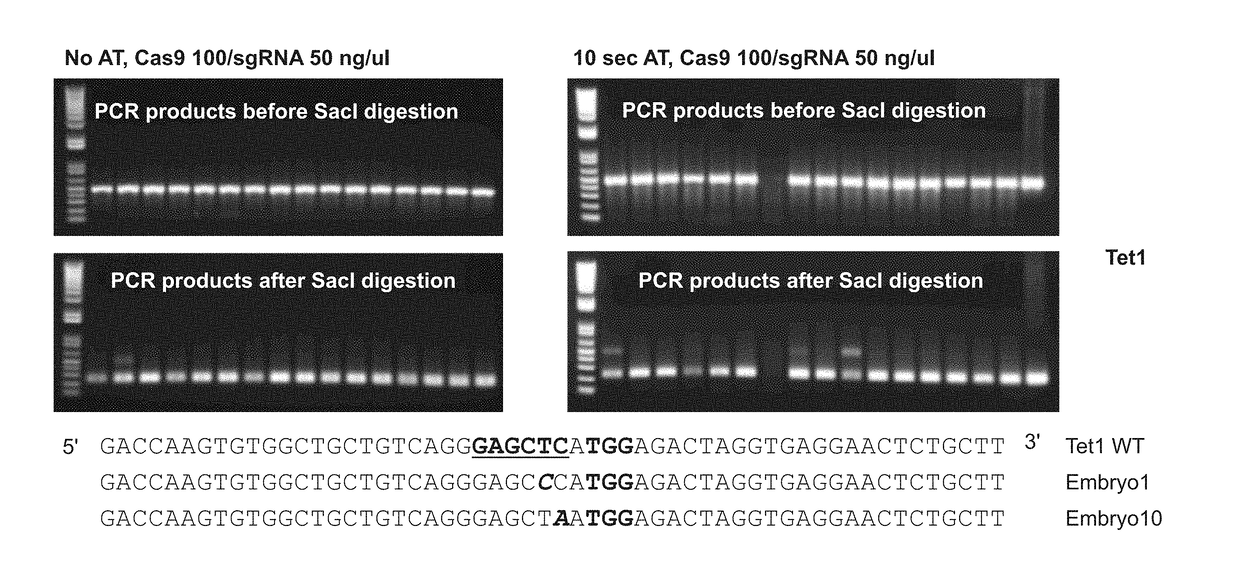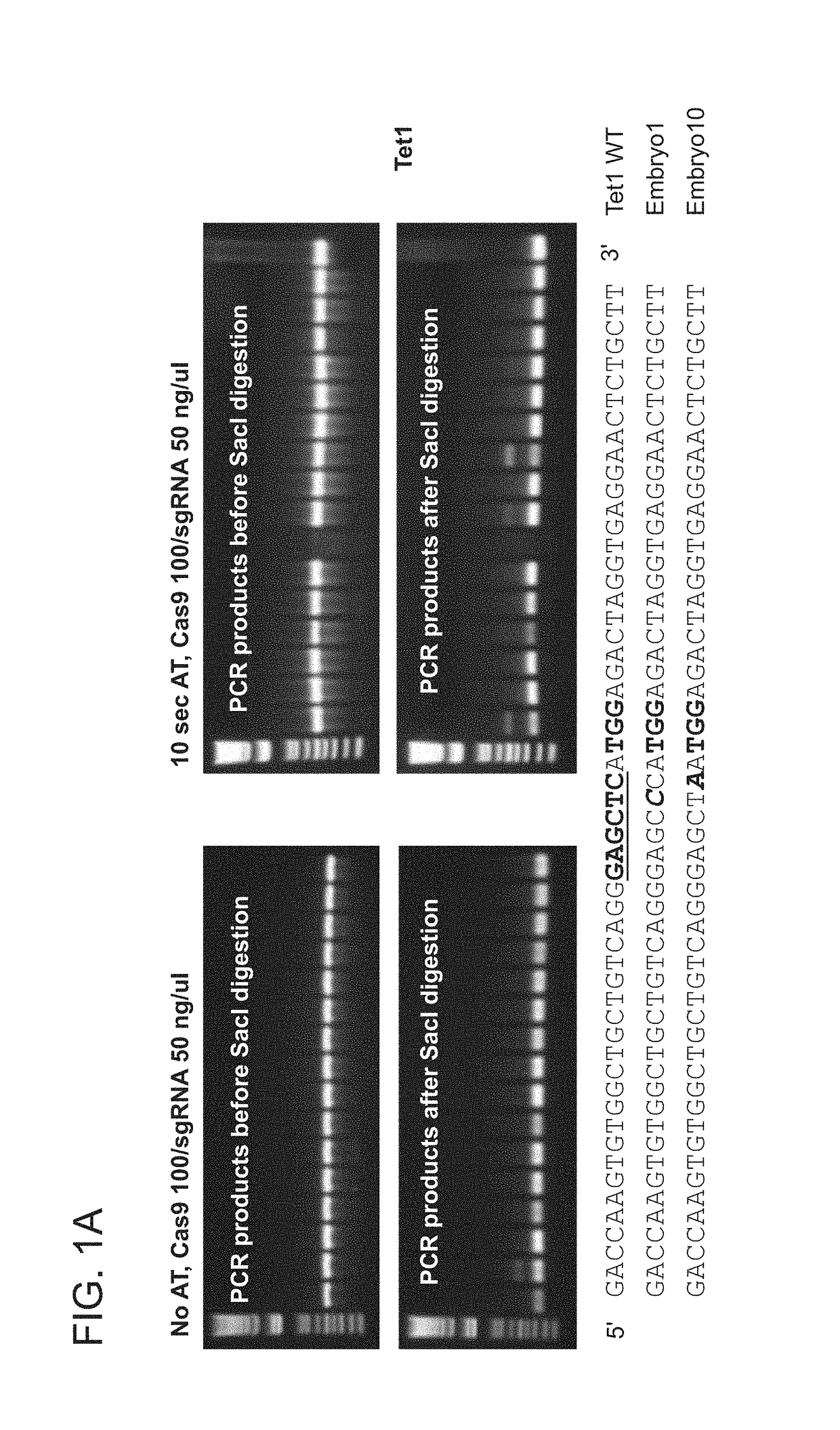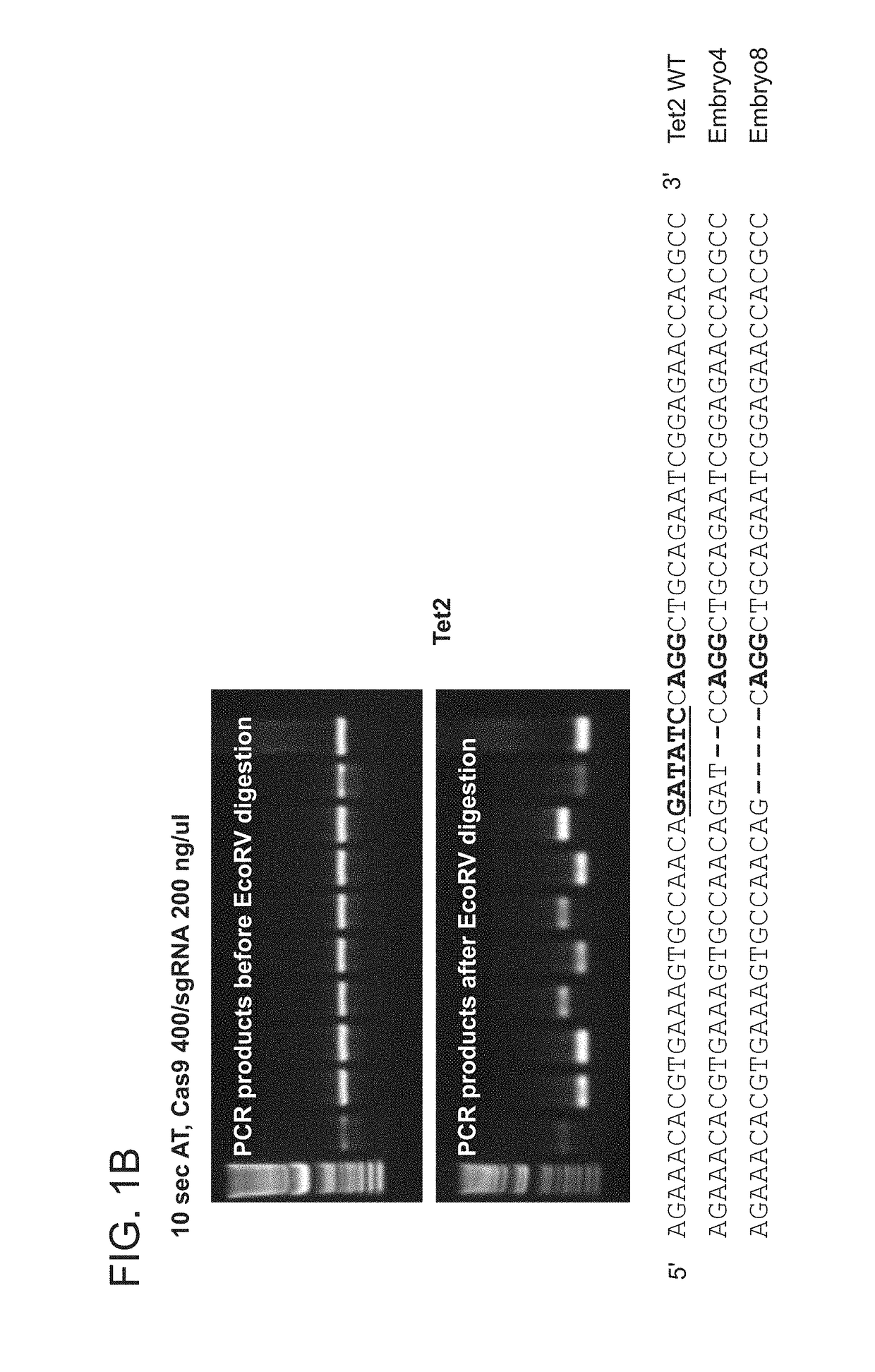High efficiency, high throughput generation of genetically modified mammals by electroporation
a genetically modified, high-efficiency technology, applied in the direction of genetically modified cells, embryonic cells, biochemistry apparatus and processes, etc., can solve the problems of high cost, high cost, and high cost of microinjection, and achieve the effect of generating genetically modified mouse models with high efficiency and high throughpu
- Summary
- Abstract
- Description
- Claims
- Application Information
AI Technical Summary
Benefits of technology
Problems solved by technology
Method used
Image
Examples
example 1
Electroporation of Mouse Zygotes and Presumptive Zygotes with Reporter-Encoding Polynucleotides
[0212]This experiment describes the result of electroporating mouse zygotes or presumptive zygotes (“zygotes” for short) with reporter-gene encoding plasmids.
[0213]The pMAXGFP vector (Lonza, USA), which carries the CMV promoter and the SV40 polyadenylation signal supporting a ubiquitous expression, was chosen for this experiment. The B6D2F2 mouse embryos were collected and treated for 5 seconds in Acidic Tyrode's solution (AT) (P / N T1788, Sigma Aldrich), washed twice in KOSMaa / BSA (P / N Zeks-050, Zenith Biotech), and placed into 25 μL of Opti-MEM (P / N 31985, Life Technologies). The embryos in 25 μL were then mixed with an equal volume (25 μL) of pMAXGFP at 80 ng / μL in TE buffer (10 mM Tris, 0.1 mM EDTA, pH 7.5) to arrive at a final DNA concentration of about 40 ng / μL, and the mixture was loaded into a 1-mm electroporation cuvette, and electroporated using the settings of: 30 volts, pulse du...
example 2
Electroporation of Mouse Zygotes and Presumptive Zygotes with CRISPR / Cas System
[0217]This experiment demonstrates the delivery of CRISPR / Cas system, using the methods of the invention, to mouse zygotes or presumptive zygotes (“zygotes” for short) for CRISPR / Cas-mediated targeted gene disruption.
[0218]For this purpose, Tea exon 4 and Tet2 exon 3 were chosen as targets, using the guide RNAs described previously (Wang et al., 2013, incorporated herein by reference). The convenience of the Tea and Tet2 systems is that the Sac1 (Tet1) or the EcoRV (Tet2) restriction sites overlap the PAM (protospacer adjacent motif) proximal sequences. As such, Restriction Fragment Length Polymorphism (RFLP) analysis can be used to detect mutant alleles, using PCR products amplified from embryos that encompass the target sites (Wang et al., 2013).
[0219]In Experiment 6, mouse B6D2F2 zygotes were first treated with AT for 10 seconds, mixed with Cas9 mRNA / Tet1 sgRNA at 40 / 20 ng / μL or 100 / 50 ng / μL, and elect...
example 3
Development of Electroporated Mouse Zygotes
[0227]In vitro culture and analysis of zygotes is an important approach, based on which a large number of parameters related to gene editing technologies can be tested and analyzed, with a quick turnaround time and preferably a lower operating cost. However, when conventional in vitro culture system was used to culture electroporated zygotes, subsequent embryonic development seemed to be retarded or aborted. Often, after electroporation of Cas9 mRNA / sgRNA at varied concentration ranges of, for example, 50 / 25 ng / μL to 1000 / 500 ng / μL, embryos progressed to different stages of development at the end of the 3.5-day culture period, including those of 1-cell, 2-cell, or 4-cell stages, morula stage, and occasionally blastocyst stage (Experiment 8). In contrast, control embryos that had not been electroporated reached the blastocyst stage at the end of the same time period, whether the control embryos had been pre-treated with AT or not. In some ex...
PUM
| Property | Measurement | Unit |
|---|---|---|
| concentration | aaaaa | aaaaa |
| concentration | aaaaa | aaaaa |
| concentration | aaaaa | aaaaa |
Abstract
Description
Claims
Application Information
 Login to View More
Login to View More - R&D
- Intellectual Property
- Life Sciences
- Materials
- Tech Scout
- Unparalleled Data Quality
- Higher Quality Content
- 60% Fewer Hallucinations
Browse by: Latest US Patents, China's latest patents, Technical Efficacy Thesaurus, Application Domain, Technology Topic, Popular Technical Reports.
© 2025 PatSnap. All rights reserved.Legal|Privacy policy|Modern Slavery Act Transparency Statement|Sitemap|About US| Contact US: help@patsnap.com



